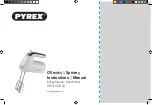
10
Each channel is equipped with a MUTE button. Pressing this button is equal
to turning the fader down, which can mute the corresponding channel output
except for the channel INSERT send and SOLO (in PFL mode). And the MUTE
LED will illuminate.
Inside your LYNX-MIX USB Series the audio signal is monitored in several different
stages and then sent to the PEAK LED. When the LED is red illuminated, it warns
you that you are reaching signal saturation and possible distortion, then you should
reduce the input level for avoiding distortion.
16 PEAK LED
SPO
TLIGHT
4. CONTROL ELEMENTS
17 MUTE Button & LED
18 ASSIGNMENT Controls
Each channel provides four push-buttons: SUB1-2, SUB3-4, MAIN L-R and SOLO.
Pressing the SOLO button, the corresponding SOLO LED will illuminate and the
SOLO signal will replace other signals send to the Headphone/Control Room and
Meters. Usually use the SOLO function in live work to preview channels before
they are let into the mix. It is useful to set an instrument's input level and EQ,
and you can also solo any channel that you want to. The SOLO switch never
affects any mix other than the Control Room. The other three buttons can be
considered as signal assignment switches. Pressing the SUB 1-2 will assign the
channel signal to Subgroup1/2, you can depend on the PAN switch to adjust the
amount of channel signal sent to the SUB1 versus SUB2, when turns the PAN
to completely left, then the signal can be only controlled by Subgroup1 and vice-
versa. In the same way, pressing the SUB 3-4 or MAIN L/R will assign the channel
signal to Subgroup3/4 or MAIN MIX L/R, and will also be affected by PAN.
19 FADER
This fader will adjust the overall level of this channel and set the amount of signal
send to the main output.
20 Control Room Source
You can choose to monitor any combination of MAIN MIX, SUB1-2, SUB 3-4 and
2TK IN via these Matrix switches. Engaging these switches, the stereo signals
will be delivered to the Phones, Control Room and Meters display.
Note: When any SOLO switch was engaged, the SOLO signal will replace other
signals, and also be sent to the Control Room, Phones and Meters.
21 PHONES/CTRL ROOM Controls
Rotate these knobs to adjust the stereo level of CTRL ROOM and PHONES
outputs separately, which can be varied from -
to MAX.
3. CONTROL ELEMENTS
SPO
TLIGHT
4. CONTROL ELEMENTS
15
These jacks will be used to send the signal to a pair
of headphone or to powered studio monitors.
45 PHONES Jack
46 LAMP
This lovable LAMP is very convenient for your operation,
it is located in the top right corner of the front panel,
and provides the 12V socket that can drive standard
BNC-type lamp.
46
45
CH1
CH2
CH3
AUX RETURNS
4
3
CH4
AUX SENDS
4
L
L
SUBGROUPS OUT
3
2
4
1
3
R
R
1
2
MAIN MIX OUTPUT (BAL/UNBAL)
L
L
L
L
CTRL OUT
DFX OUT
1
2
MONO
RING RETURN
TIP SEND
R
R
FOOT SWITCH
R
R
(BAL/UNBAL)
L
LEVEL
OUTPUT
MAIN
L
R
R
PHANTOM
POWER
DIRECT OUTS (BAL/UNBAL)
ON
OFF
AC INPUT
100-240V
50/60Hz
RATED POWER CONSUMPTION: 65W
Fuse: T1AL
Apparaten skall anslutas
till jordat uttag nar den
ansluts till ett natverk
CH5
CH6
CH7
CH8
4
3
2
1
SUBGROUPS INSERT
-
+15
8
0
+4dBu
-30dBu
USB
MAIN INSERT
SUB
1/2
CH
15/16
MAIN
MIX.
MAIN
MIX.
RECORD
PLAY BACK
Rear Panel
This switch is used to turn the main power ON and OFF.
47 POWER ON/OFF Switch
48 +48 Volt Phantom Power
It is available only to the XLR MIC sockets. Never plug in a microphone when
phantom power is already on. Before turning phantom power on, make sure
that all faders are totally down. In this way you will protect your stage
monitors and main loudspeakers.
47
48
Use it to connect your LYNX-MIX USB Series to the main AC with the
supplied AC cord. Please check the voltage available in your country and how
the voltage for your LYNX-MIX USB Series is configured before attempting
to connect your LYNX-MIX USB Series to the main AC.
49 AC Inlet with FUSE Holder
49
50
51 52
53 54
55
56
57 58
59
60
61
62
63
64
65
































